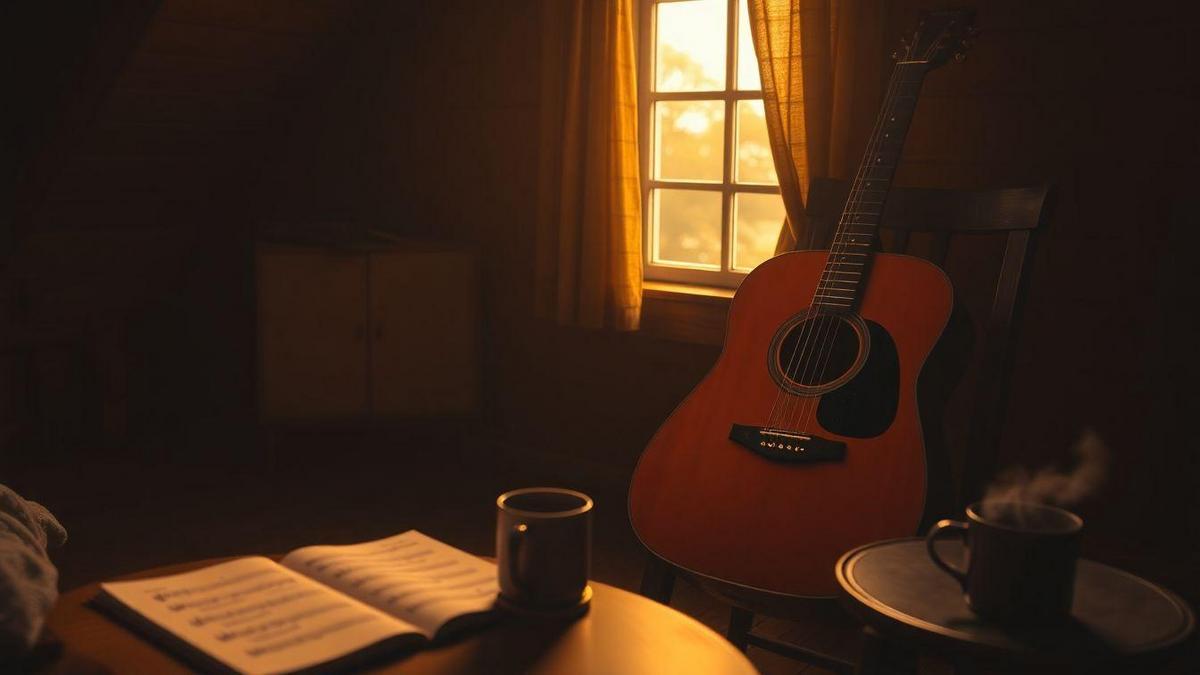The beauty of making music just for yourself is what pulls me into my room. I write about how I use solo creation for emotional catharsis: the small signs I feel lighter after a session, simple ways I turn feelings into sound, and my tiny breathing-and-playing routines. I explain why I practice self-directed improvisation, the tools I grab first, and my short improv warmup. I show how I shape songs alone with my songwriting steps, quick home-demo habits, and how creative solitude built my confidence. I cover my basic home studio gear, easy recording steps, meditative music routines for calm, mood-to-sound mapping, and how I decide to keep music private or share it.
Key Takeaway
- I feel calm and safe when I make music alone.
- I learn and grow at my own pace.
- I can try new sounds without fear.
- I connect with my feelings through my music.
- I recharge and find joy in solitude.
The beauty of making music just for yourself is that it gives you a private space to experiment, heal, and build skill without pressure.
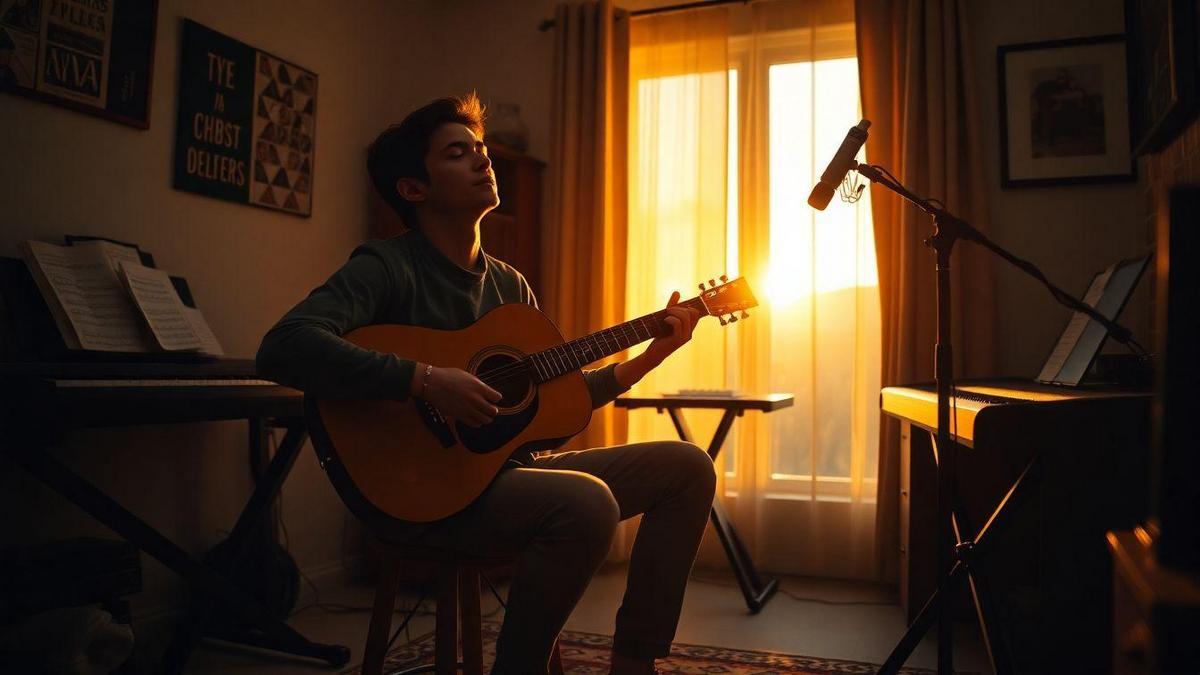
How I use solo music creation for emotional catharsis
I sit with my instrument and let whatever is inside come out—sometimes a whisper, sometimes a shout. A solo session is like opening a window in a stuffy room: I breathe, I play, and I watch feelings shift. The beauty of making music just for yourself is that you can be honest and messy. No score, no audience—just sound. For me this often aligns with ideas from music as therapy, where playing becomes a gentle way to clear the mind.
I do short sessions when I’m tense and longer ones for deeper things. Keep it simple: a mood, a motif, a few minutes. The goal is release, not perfection. Music becomes a language for what words can’t hold.
Signs I feel better after a session
- Breathing eases — breaths come slower.
- Tension drops — shoulders and jaw loosen.
- Mind quiets — the loop of worry breaks.
- Mood lifts — I feel lighter.
- Small clarity — one new idea appears.
- Sleep improves after evening playing.
I check these after each session. If a few show up, I know the music helped. See how music-making supports emotional wellbeing.
Simple ways I turn feelings into sound
- Humming low or high to match the emotion.
- Rhythm stamping: tap a pattern like a heartbeat.
- Drones: hold a note and change volume to ride an emotion.
- Call-and-response with myself: play a phrase, answer it differently.
- Melodic contour: let anger climb fast, sadness fall slow.
- Tempo shift: speed up for energy, slow down for grief.
Pick one idea and repeat it—repetition sweeps feelings into place. For adding nuance I often refer to techniques about how to add emotion to every note. Tools: voice, guitar, keys, a small drum, or even a table.
Short breathing and playing routine
- Sit tall for 30 seconds and close your eyes.
- Inhale 4 counts, hold 2, exhale 4 — repeat 3 times.
- Choose one sound (hum, note, beat). Play it for 1 minute with steady breath.
- Improvise for 5 minutes. Let mistakes stay. Follow mood, not rules.
- Slow down and play one soft ending note. Breathe out fully.
- Spend 1 minute noticing how you feel and name one change.
This quick routine resets my body and gives feelings a safe place to live for a bit.

Why I practice self-directed improvisation
I improvise because it loosens tight spots in my mind. When I drop expectations, I find new colors and honest phrases. The beauty of making music just for yourself shows up here: I stop judging and start listening. That small shift turns a stuck idea into something alive. If you’re new to this, simple guides like improvisation made simple for absolute beginners can help break the ice.
How improv helps me hear new possibilities
- It breaks habits: I stop repeating the same licks and find fresh lines.
- It highlights tiny moments: a short rhythm or stray note becomes a theme.
- It teaches risk: I try odd intervals and learn what feels true.
- It grows confidence: small risks lead to bigger choices I trust.
- It opens emotion: I find melodies when words fail.
Once, humming nonsense over a chord loop produced a chorus melody later used in a song. Those surprises keep me going.
Tools I use to start self-directed improvisation
- Instrument (guitar, piano, voice) — something within reach.
- Recorder (phone or small digital recorder) — to capture failures and gems.
- Metronome or simple beat — keeps me grounded.
- Headphones for focus when needed.
- Notebook or notes app for quick cues.
- Constraints (one scale, one mood) — limits spark ideas.
- Prompt cards (word, tempo, emotion) — quick nudges to start.
I treat these as friendly aids, not rules. A phone recorder is my best friend; I rarely remember what I played unless it’s recorded. If you’re exploring ear-based playing, what playing by ear really means helped me understand the basics.
Five-minute improv warmup
- Breathe 30 seconds and let shoulders drop. Ease is the point.
- Hum one note for 30 seconds. Find comfort in one sound.
- Set a slow beat (60–80 bpm). Play a simple pattern for 60 seconds.
- Use only three notes for 60 seconds. Push against the limit.
- Record 60 seconds of free play. Don’t stop; don’t judge.
- Listen back for 30 seconds and mark one moment to keep.
- Save the clip and write one line about how it felt.
This wakes my ears and often seeds a larger piece. If you need prompts to get started, try ideas from breaking creative blocks in music.

How I write songs alone with solitary songwriting techniques
I write alone because quiet lets feelings breathe. I treat a seed idea like a found photo: hold it up to the light, turn it, and listen. I pick one focus—a mood, a phrase, or a sound—and stick with it until it grows. I call this gentle excavation: digging around the idea without pressure. Often the best lines come while washing dishes or walking the dog. A recorder and a notebook teach the value of the moment and reinforce the beauty of making music just for yourself.
My step-by-step method to capture an idea
- Notice the spark and name the feeling (sad, silly, curious).
- Record instantly: hit record and sing or hum the core melody—no quality control.
- Write one line that holds the idea; if fuzzy, write three images until one feels true.
- Find a chord or riff that makes the line breathe.
- Set a tempo: fast = urgent; slow = tender.
- Expand with questions: Who? What happened? Where? Let answers lead to verses or chorus.
- Keep it raw: make a quick demo (30–90 seconds) so the emotion stays intact.
When I’m stuck on melody, a short read on writing your first melody without overthinking reminds me to trust the first idea. If theory feels like a barrier, the piece on does theory help or harm songwriting helped me keep harmony useful, not overwhelming.
Song shapes I use: verse, chorus, bridge
- Verse: tells detail and moves the story forward—short lines, small images.
- Chorus: holds the main feeling and the hook—simple and repeatable.
- Bridge: offers a twist—a different chord or lyric angle to refresh the song.
Quick home demo checklist
- Quiet space: close windows, turn off fans.
- Phone or simple recorder: check battery and storage.
- One instrument: keep it simple.
- Click or tapped tempo for structure.
- Short takes: multiple 30–90 second versions.
- Label files: date idea word (e.g., 2025-09-18_lonely-cafe).
- Backup: upload to cloud or email to yourself.
If you want to turn demos into consistent habit, see tips on creating a simple daily practice routine and making practice fun.

How creative solitude built my confidence and focus
I used to see practicing alone as a waste. Then I found silence is a warm room where ideas can breathe. I sat with a cheap keyboard and a notebook, made mistakes out loud, and laughed at bad riffs. Small sessions became my training ground for confidence and deep focus.
When I improvise alone, I try wild choices without fear. That freedom made me bolder on stage — a change I explored further in how music can boost your confidence. Solo work sharpened my attention; I began finishing pieces and saying, I can do this. The beauty of making music just for yourself shifted from a sentence into a habit—calmer, clearer, and more willing to take risks.
Small habits that raised my musical self-esteem
- Five-minute warmups every day. Small wins add up.
- Recording one idea each session. Listening back builds perspective.
- Celebrating tiny wins: a phrase that worked, a clean run.
- Daily listening walk: pick one detail to copy.
- Mini goals: chord change one day, a mood the next.
- Play like no one’s watching for ten minutes—freeing from judgment.
Practical rituals also helped; see ideas in rituals that help you enter practice mode and ways to stop procrastinating in how to stop procrastinating on music practice.
How private practice improved my public skills
I treated solo time like a lab: test phrasing, tempo, and timing, then bring the good parts into a real room.
- Simulate performance: set a timer and play a full piece without stops.
- Record and review: listen with a pencil; mark what felt honest.
- Slow the hard parts to half speed until they feel easy.
- Rituals: a breath exercise and a quick run-through calm me before gigs.
A shaky-hand memory at a small show reminded me: private practice gives quiet authority and the ability to turn mistakes into choices — a mindset covered in turning mistakes into learning opportunities.
Weekly reflection prompts
- What sounded surprising this week? Name one moment.
- What felt shaky? Pick a spot to practice slowly next session.
- What did you try that felt brave? Write one word.
- Which habit helped you keep going? Keep or tweak it.
- How did you respond to failure? Shut down or try again?
- What song moved you? Try copying one small element.
- What will you do next week to push one tiny boundary?
Keeping a short log helps; see should you keep a practice journal for a tidy method.
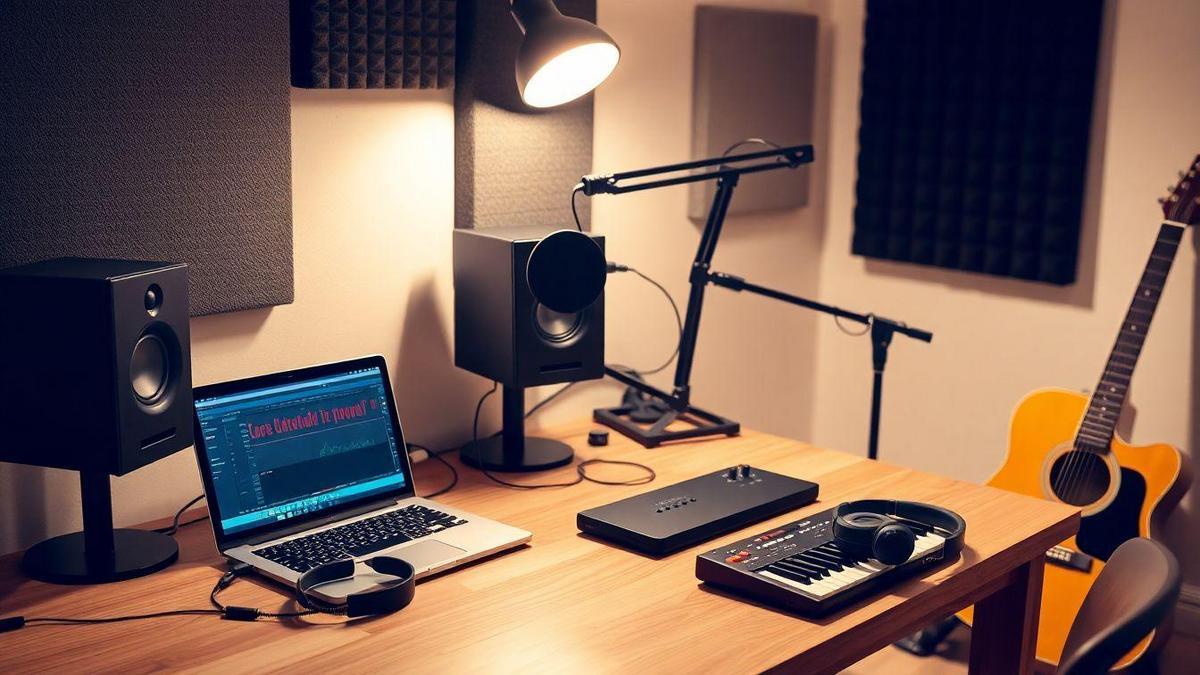
How I run a simple home studio for independent music making
I keep my home studio simple and practical—tools that capture ideas fast so I stay creative and don’t get stuck fiddling. Treat the space like a cozy workshop: a place to play, fail, and grow.
Essential gear that gives the best results
- Microphone: a reliable condenser for vocals, a dynamic for loud sources.
- Audio interface: the bridge between instruments and computer.
- DAW: pick one and learn it—where you record, edit, and mix.
- Headphones: closed-back for tracking, neutral for mixing.
- Monitor speakers: small nearfields to check balance.
- MIDI controller/keyboard for quick ideas.
- Acoustic treatment: a few panels and bass traps to tame reflections.
- Cables and stands: keep spares.
- Pop filter and backup drive.
Easy recording steps I follow at home
- Set the mood: clear distractions, make tea, pick a tempo or chord.
- Prepare signal chain: microphone → interface, set gain, check levels.
- Create a rough arrangement: lay down click or guide guitar.
- Track the main part first: capture vocals or lead instrument raw.
- Add supporting layers in short passes.
- Comp and edit: pick best phrases, trim breaths or clicks.
- Quick mix pass: rough balance, basic EQ and compression, check on both headphones and monitors.
- Print stems or a stereo mix and save session copies to backup.
- Rest and return: fresh ears catch fixes you miss right away.
A simple checklist keeps sessions moving; for motivation on slow days, check staying motivated when progress feels slow and what to do on days you’re unmotivated.
Basic home studio checklist
- Computer with enough RAM and disk space
- DAW installed and set up
- Audio interface connected and drivers updated
- Microphones and pop filter ready
- Headphones and monitor speakers checked
- Cables and mic stand on hand
- MIDI controller connected (if used)
- Acoustic treatment placed around main listening spot
- Backup drive for session copies
- Power strip and surge protector

How meditative music making helps me relax and focus
I turn to sound like I turn to a friend. Playing slowly makes the room breathe with me. I feel calm, thoughts untangle, and I hold focus without forcing it. A simple pattern—a hum, a slow chord, a steady beat—pulls me into the present. That stillness is small and fierce; it’s my anchor. There’s growing research on music and mood regulation that supports these calming effects.
Rhythms and tones I use for calm
- Slow pulse (50–70 BPM) — heartbeat tempo that steadies.
- Long drones — single notes that smooth jagged thoughts.
- Open fifths and major sixths — warm, honest intervals.
- Soft percussive taps — grounding without jerking the mind.
- Breathy, low-register tones — instruments or voice that feel like a hug.
Tempo table:
| Tempo (BPM) | Feel | Instrument ideas |
|---|---|---|
| 50–70 | Grounding | Cajón, low synth pad, cello |
| 70–90 | Easy groove | Acoustic guitar, hand drum |
| 90–110 | Light motion | Soft piano, muted marimba |
Short routines that feel like meditation
- One-note breathing: play a note on the out-breath and let it fade; repeat 6–8 times.
- Three-chord circle: three calm chords, each for four slow counts, loop 3–5 minutes and hum along.
- Call-and-response with myself: improvise two bars, echo it back softer.
- Rhythmic counting: tap a steady four-count and say numbers softly to steady the mind.
For deeper ideas on musical mindfulness, see music as therapy and tips for shaping tone in how to add emotion to every note.
Two-minute grounding exercise
- Set a timer for 2 minutes. Sit comfortably and place a hand on your belly.
- Take one deep breath and play a low note or hum a single tone on the out-breath.
- Inhale for 3 counts, exhale and play for 4 counts. Repeat six times.
- Finish with two slow taps on the chest or lap and notice how breath and sound changed your pulse.

How I find my personal musical expression in introspective composition
I write like I’m talking to myself: cup of tea, a simple chord, and the question—what am I feeling right now? Small sounds lead. I hum until a melody feels like my voice again. I trust pauses as much as notes. The goal is a song that sounds like me—messy, honest, breathing.
- Start small: one chord, one rhythm, one image.
- Treat voice like clay: shape it, then listen.
- Keep recordings on my phone and revisit them like old letters.
- Cut anything performative; if it rings false, drop it.
A half-remembered melody once became a chorus about fear. I kept the rough edges; vulnerability gave the song life. That’s when I feel the beauty of making music just for yourself.
Questions I ask to keep songs honest
- What am I actually feeling? Name it.
- Who am I singing to? Me, someone else, or an idea?
- Why does this line matter right now?
- Would I say this aloud? If not, rewrite.
- What part of this melody surprises me?
Answer in quick notes or voice memos. Delete flattering-but-empty lines. Keep the ones that make your throat tighten. For thinking about memory-driven material, read about the link between music and personal memories.
Sounds and words that match mood
- Sad: soft piano, faded reverb; words like remember, alone, rain.
- Angry: distorted guitar, staccato drums; verbs like break, shout, leave.
- Hopeful: bright ukulele, layered vocals; imagery like morning, open road, lift.
- Playful: syncopation, toy piano; verbs that skip like bounce, spin, laugh.
Mood-to-mode mapping
| Mood | Scale / Mode | Typical Instruments & Words |
|---|---|---|
| Melancholy | Minor (Dorian / Aeolian) | Soft piano, cello, low synth — fade, hold, still |
| Tension / Anger | Phrygian / Harmonic Minor | Distorted guitar, tight drums — shatter, fight |
| Warmth / Comfort | Major (Ionian) | Acoustic guitar, warm strings — home, breathe |
| Dreamy / Reflective | Lydian / Mixolydian | Pad synths, ambient bells — float, memory |
If modes feel daunting, a short primer like a beginner’s guide to harmony or five theory basics can make choices easier. I don’t stick to rules—try pairs and swap until the mood fits like a shoe.
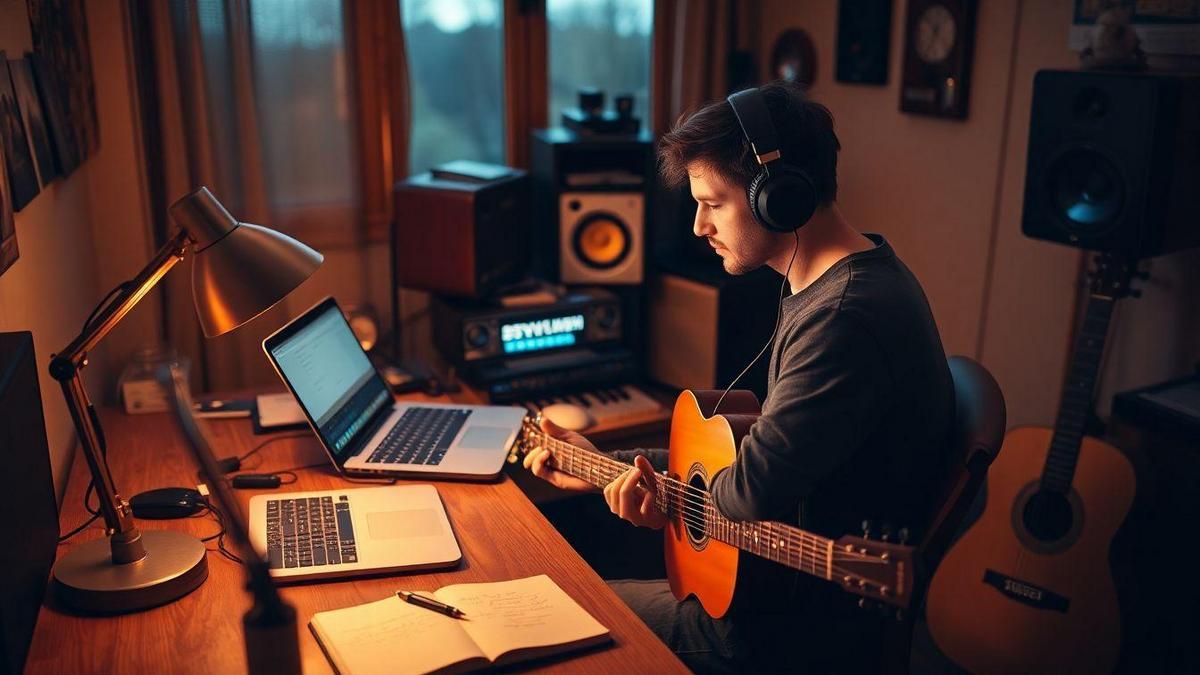
How solo music creation sharpened my skills and craft
Making music alone forced me to solve problems I used to pass to a teacher or bandmate. Over time I saw clear gains in timing, phrasing, and confidence. I learned to trust small choices—a tiny rhythm change, a different chord color—and they added up. The process felt like carving wood: each pass made the shape clearer.
Practice routines that gave real progress
- Warm-up (7–10 minutes): simple scales, breathing, finger drills—consistency over speed.
- Skill block (15–25 minutes): one specific goal—repeat slowly, then add feel.
- Creative block (10–20 minutes): improvise or write something new; record the best idea.
- Reflection (5 minutes): note one win and one next step.
Short, smart sessions beat marathon days. Mixing routine and play built real progress. See how to create a simple practice routine and why consistency beats raw talent for steady gains.
Using simple recordings to track growth
- Record with your phone or a basic app—honesty over quality.
- Label takes with date and a one-line note: what I tried, what I liked.
- Listen the next day with fresh ears; be kind, be specific.
Hearing patterns—rushed choruses, misplaced space—allowed quick adjustments. Over months, tiny fixes became bigger musical choices. Keep a short log and consider whether a practice journal would help.
Simple progress log
| Date | Focus | What I heard | Next step |
|---|---|---|---|
| 2025-01-10 | Rhythm consistency | Rushed the 2nd bar | Slow metronome, 10 min |
| 2025-02-02 | Phrase endings | Better space, still tense | Relax shoulders, 3 takes |
| 2025-03-15 | New riff | Clear idea, needs variation | Write 2 alternate endings |
Keep the log short—one line per session is enough. Review weekly and pick one theme to practice.
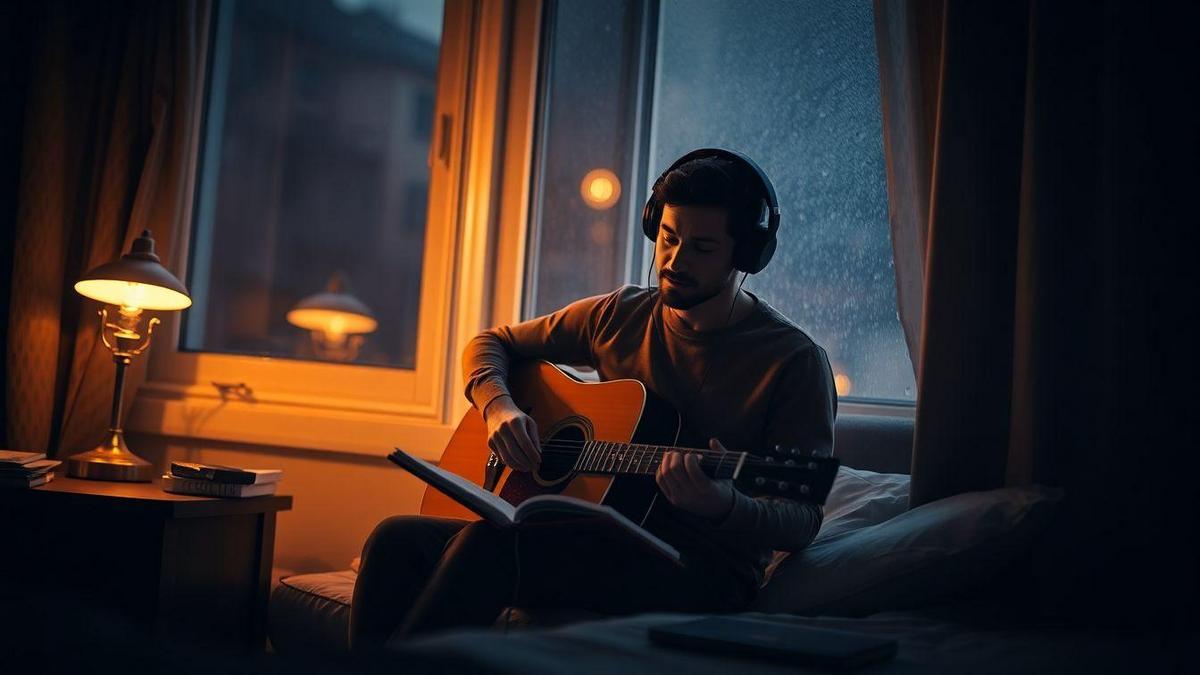
Why I sometimes keep songs private: The beauty of making music just for yourself
Some songs are journals. I write them for a moment, a mood, or a person in my head. Keeping music private gives space to breathe and to play with raw ideas without pressure. The beauty of making music just for yourself is that it can be honest and quiet—it can heal.
Benefits I get from keeping music to myself
- Freedom to experiment with odd chords and messy lyrics.
- Emotional safety to work through pain or joy privately.
- Skill growth: phrasing and timing without an audience.
- Creative confidence: learn your voice in private before sharing.
- True expression: some songs should remain intimate, like a letter never sent.
I once wrote a short melody after a breakup and never played it for friends. It patched a torn sweater—quiet, useful, private—and helped me sleep better. That was enough.
How I decide when to share or stay private
- Ask: Why do I want to share? If it’s for praise, I wait.
- Check the song’s purpose: practice, therapy, or a finished piece?
- Test vulnerability: will revealing it hurt someone? If so, keep or edit.
- Gauge readiness: do I feel proud or defensive about it?
- Think about timing: some songs age into public life; others should stay in a drawer.
If I hesitate, I hold back. If I feel excited and calm, I share. When I do open up, I’ve found the joy of playing with other people is a different kind of reward.
Privacy checklist before sharing
- Consent: If lyrics mention someone else, do they agree?
- Emotional risk: Will sharing reopen wounds for me or others?
- Quality comfort: Am I okay with rough edges being heard?
- Legal basics: Do I own the samples, lyrics, and recordings? See the official guide to music copyright basics.
- Future plan: Should this live online forever or be temporary?
- Feedback readiness: Can I take praise and criticism without losing joy?
Run through this like a quick warm-up—it clears the head.
Conclusion
One simple truth keeps bringing me back: making music alone is a safe room where solitude becomes a tool, not a wall. I sit, breathe, and let sound sweep emotions into place. Small routines, a trusty recorder, and tiny warm-ups turn nervous energy into steady confidence. I treat mistakes as clues, keep some songs private, and let others walk out the door when they’re ready. That balance—between practice and play, hiding and sharing—keeps my work honest and alive.
If you want something gentle to try, pick one idea, record it, and call it progress. The beauty of making music just for yourself will make the room feel lighter. For more practical routines and ideas, see how to create a simple practice routine daily.
